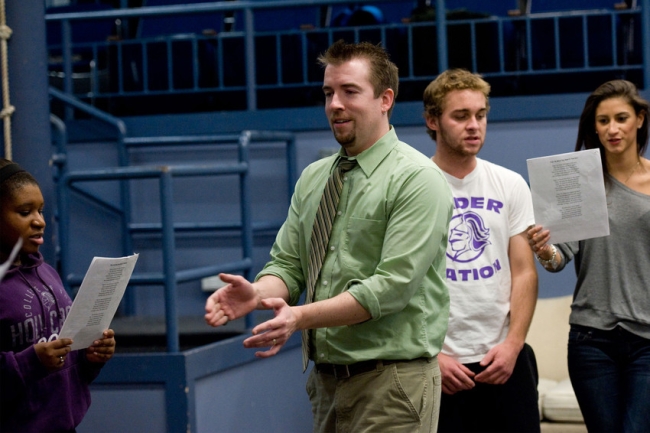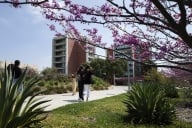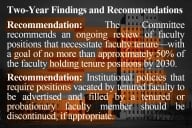You have /5 articles left.
Sign up for a free account or log in.

Scott Malia, center, was a visiting assistant professor at the College of the Holy Cross before he landed a tenure-track job there.
College of the Holy Cross
Lots of critics say the growing number of new Ph.D.s who accept visiting assistant professorships is another symptom of the breakdown of the traditional academic labor market. These positions are in many ways better than adjuncting, in that they provide a year or two of job security and typically include decent pay, health insurance and an office. But unlike a true assistant professorship, the track is strictly visiting and doesn't lead to tenure. And while it’s true that most visiting assistant professors would probably prefer a tenure-track job straight out of graduate school, some say the experience can be valuable -- especially if they’re at an institution that views itself as responsible in some way for the success of these new faculty members.
The College of the Holy Cross is by no means the only institution to adopt such a sense of responsibility; there are numerous examples of colleges and universities that treat visiting assistant professors as respected members of the faculty, not just temporary workers plugging holes in the teaching schedule. But both visiting assistant and tenure-line professors at Holy Cross say theirs is an example of what a visiting assistant professor program should look like.
“The mentorship experience was above and beyond what anybody -- certainly I -- but anybody could have expected in a number of ways,” said Matthew Dinan, who served as a teaching-intensive postdoctoral student for two years and visiting assistant professor in political science for one year at Holy Cross before landing a tenure-track position elsewhere. “From the get-go, every decision that was made was done with a view toward helping me, so helping me fill out my [curriculum vitae], and helping me build skills that are relevant to teaching at a liberal arts college, and support for research.”
Beyond that, Dinan -- who is now finishing his first year as an assistant professor and the St. John XXIII Chair in Catholic Studies at St. Thomas University in New Brunswick, his alma mater -- said he felt like a full member of the department as a visiting assistant professor at Holy Cross. He had say in academic matters and was encouraged to teach courses of his own design, and he mentored undergraduate students completing theses. Senior faculty members offered guidance along the way with an enthusiasm that Dinan attributed to Holy Cross’s culture and, probably, an unfulfilled desire to mentor graduate students. The institution is a small, selective, undergraduate-only liberal arts college located about an hour outside Boston.
Rather than being “exploitative, which I know can happen,” Dinan said, the assistant-professorship experience gave him an advantage over others on the tenure-track job market. He said he came to St. Thomas knowing how to balance various aspects of his work and with tested syllabi and advising experience -- the latter being particularly marketable.
“Even just knowing what questions to ask has made that learning curve easier for me,” Dinan said of being on the tenure track after his stint as a visiting professor.
In 2008, Holy Cross received an $800,000 grant from the Andrew W. Mellon Foundation to establish postdoctoral fellowships at the college, six scholars over four years. The idea was to give new Ph.D.s -- many of whom have spent their entire academic careers at large research institutions -- the opportunity to teach at a liberal arts college, said Margaret Freije, vice president for academic affairs and dean. “So many of them haven’t had exposure to what teaching at a liberal arts college might be like, and what that teacher-scholar model might look like. … We wanted to help them decide if teaching at a liberal arts college might be something they were called to do.”
Whether the scholars stayed at Holy Cross or another liberal arts institution in the long run was immaterial, Freije said. “We compete with each other for lots of things, but we’ve also been collaborators. We want the best teachers and scholars at liberal arts colleges since we still sink or swim together in reality.”
The postdocs got two-year positions with reduced teaching loads, a designated faculty mentor for scholarly and pedagogical support, and various other assistance, such as travel funds for conferences. The fellowship program got such good reviews from postdocs and faculty members that Holy Cross decided to add visiting assistant professors to its ranks. They receive similar support to postdocs, but teach a full, 3-3 load. They’re on one-year contracts but most stay two years. (The college also maintained a handful of postdocs beyond the original terms of the Mellon grant.)
Holy Cross pays its visiting assistant faculty relatively well, between about $52,000 and $58,000 annually. All receive full benefits. Next year’s starting salary for visiting assistant professors with Ph.D.s is $53,400.
There are currently 3 postdocs and 30 visiting assistant professors at Holy Cross, spread out among various disciplines. The number of full-time, visiting assistant professors is roughly equal to the number of tenured and tenure-track faculty members on leave at a given time. The college employs very few part-time adjunct professors, and those on the faculty typically have other positions and are hired for their professional expertise.
To develop the new visiting assistant professor track, “What we did was work with [department] chairs to think about how you would mentor these people,” said Freije. Chairs would drop in on the visiting professors’ classrooms to offer guidance and to be able to write strong recommendation letters. They’d advise the visitors on how to balance teaching and research to be able to snag that elusive tenure-track position and, where possible, draw on their own professional networks to help visiting faculty members make connections.
Visiting faculty members also are invited to all orientations for new tenure-track faculty, with sessions on such practical topics as how to apply for grants or work with at-risk students.
Catherine Roberts, chair of the mathematics and computer science department at Holy Cross, said she once remembered jokingly saying to Freije about mentoring the postdocs and visiting assistant professors, “This takes up a lot of my time -- this is a lot of work.” Roberts said that Freije replied, “But that’s our job, to do the best we can by these young scholars launching their careers.”
Roberts said that there’s a sense of “shared responsibility” for the newest scholars at Holy Cross, but that the relationship is two-way. Visiting assistant professors participate in all curricular decisions and have taught upper-level courses, contributing new insights to department life, she said.
“I think that’s very different in some places -- in a math department you might have the [non-tenure-track faculty] teaching the lowest-level classes,” she said, noting that Holy Cross sponsors visiting assistant professors to attend at least one conference, and sometimes two.
“We visit their classrooms if they want, but don’t require it,” she said. “There’s no formal report, but we’ll go out for lunch or coffee afterwards and talk about what I observed. We want the visiting professors to feel very comfortable trying out things in the classroom.”
Emily Schmidt, a visiting assistant professor of psychology, is completing her third year at Holy Cross (she’ll be there for one more year as she continues her tenure-track job search). She said she’s been struck by two different chairs’ desire to help her beyond the scope of her employment at the college, such as advice about how to take her research in a new direction, despite the obvious fact that her career will likely take her somewhere else.
She’s been able to teach upper-level courses within her areas of interest (nonverbal communication and emotion), she said, and otherwise hone her teaching skills. With a 3-3 load, there’s not as much time for research as she’d like, but “I think you’d hear that from anyone anywhere.”
So does liking Holy Cross so much make it harder to think about leaving? Schmidt said, “To be completely honest, it does make it harder to leave.” But, she said, “I’ve had individuals here who are tenured be frank with me about pursuing my own goals. That’s important -- the reality of it isn’t something that goes unacknowledged.”
Sometimes the stars align and postdocs or visiting assistant professors do get to stay at Holy Cross -- precisely eight since 2009. Scott Malia, now in his fourth year on the tenure track in theater, was a postdoc and visiting assistant professor before a permanent position opened up in his department. The theater faculty still conducted a national search, and Malia had to apply and interview like everyone else. But having a strong track record and a sense of familiarity with the department probably helped his case, he said.
Now that he’s on the tenure track, Malia said his previous positions at Holy Cross have helped him manage his teaching, service and writing commitments. The mentoring he received, especially from his department chair, helped him advance as a teacher and theater scholar, he said.
“I think that real-world experience before getting this type of permanent position is valuable in a lot of different ways.”
It’s hard to know exactly how many Ph.D.s take visiting assistant professorships on their way to tenure-track employment. The data sets are better for postdocs, and even those aren’t complete, said Gregory Petsko, Arthur J. Mahon Professor of Neurology and Neuroscience at Weill Cornell Medical College and lead author of a 2014 National Academy of Sciences, National Academy of Engineering and Institute of Medicine report calling for better mentoring and pay for postdocs.
Petsko said the report committee didn’t consider visiting assistant professors specifically, but that many of its recommendations about postdocs are appropriate for their ranks, as well.
“You’d think that would be the minimum, wouldn’t you?” he asked.
Petsko said it was his sense that how visiting assistant professors are treated varies “wildly” from institution to institution, but that small liberal arts colleges seem to best integrate them into the faculty. He attributed this to the fact that liberal arts institutions put a premium on teaching undergraduates and offering a lot of faculty-student interaction. So regardless of visiting assistant professors’ tenure status, or lack thereof, he said, “They’re being brought in there to teach and contributing to the core mission of the institution.”
At larger, research-oriented institutions, however, Petsko said, the core mission is less teaching than research. So faculty members who don’t participate fully in that endeavor are less valued, he said. Generally, he added, becoming a “contract faculty member” anywhere but at a liberal arts college after a postdoc is a “dangerous” route for someone hoping to land a tenure-track job.
Karen Kelsky, an academic career adviser known for her frank counseling about the state of the academic job market and author of the forthcoming book The Professor Is In: The Essential Guide to Turning Your Ph.D. Into a Job (August, Crown Publishers/Random House), said she agreed that the best visiting assistant professorships were at selective liberal arts colleges.
These jobs aren’t without drawbacks -- namely having to move on at some point -- Kelsky said, but she’d definitely recommend one to someone who didn’t land a tenure-track position on the first try.
“One [visiting assistant professorship] at an elite institution that provides you with teaching and networking opportunities and offers a reasonable teaching load and time to publish -- that could be an excellent stepping stone to the tenure track,” she said via email. But it’s not a permanent gig -- doing one visiting professorship after another is a kind of “hamster wheel” that ultimately hurts, not helps, one’s career.
“The problem is when you do one after another for three or more years,” Kelsky said. “The constant relocating is draining. And circumstances differ widely. Some [positions] offer low teaching loads and some research or conference funding; others do not. But the first year of teaching at any new institution is challenging for anyone, even on the tenure track, and little writing gets done. So when you are only repeating a series of such first years, then your writing for publication is delayed, and you become less competitive for the tenure track, rather than more.”









